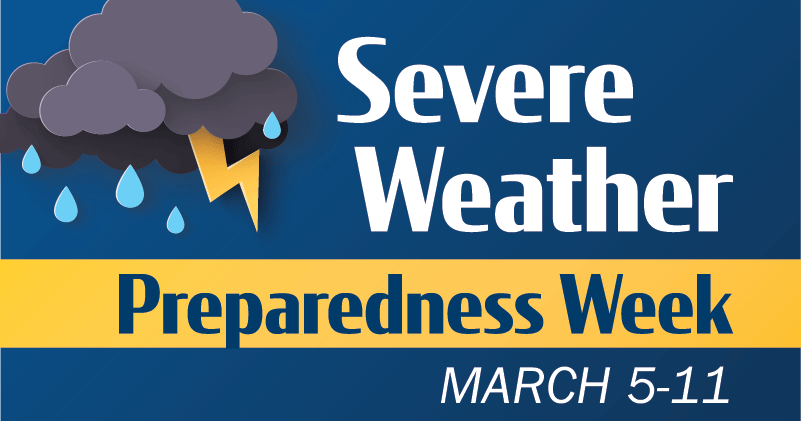
Topics
- Monday: Severe Thunderstorms and Tornadoes
- Tuesday: Severe Weather Alerts and Tornado Drill
- Wednesday: High Winds, Hail and Tornadoes
- Thursday: Lightning
- Friday: Flash Floods
- Saturday: Make a Plan
The alarm test, which will come in the form of a Required Monthly Test, will activate the State Emergency Alert System and be carried by local radio broadcasters. Every school, business and residence is encouraged to participate in this drill. It’s really easy: at 9:30 a.m. on Wednesday, take a few moments to practice your severe weather safety plan, and seek shelter for a few minutes as if a tornado was headed your way.
One of the keys to staying safe during the severe weather season is making sure that you have a way to receive lifesaving severe weather watches and warnings. There are many methods and tools, some of which are available with no cost or fees, that you can use to receive these important lifesaving alerts no matter where you are – at home, at school or at work.
| Method | Description |
|---|---|
| NOAA Weather Radio (NWR) | NWR is a nationwide network of radio stations broadcasting continuous weather information from the nearest National Weather Service office. Specially built receivers, which can be purchased at most electronics and large retail stores for less than $40, receive the NWR broadcast 24 hours a day, seven days a week, and sound an audible alert when official watches and warnings are issued for your area. Think of these radios as a “smoke detector” for severe weather alerts. |
| Wireless Emergency Alerts (WEA) | With WEA, emergency alerts can be sent to your cell phone or mobile device when you may be in harm’s way, without need to download an app or subscribe to a service. In addition to other alert types such as AMBER Alerts, this free service will transmit extreme weather warnings such as Tornado and Flash Flood warnings to your cell phone. The alerts will look like a text message and will typically show the type and time of the alert and any action you should take. WEA messages include a special tone and vibration. If you receive a WEA message, you should follow any action advised by the emergency message. Seek more details from your favorite TV or radio station, NOAA Weather Radio, news website, desktop application, mobile application or other trusted source of information. |
| Cell phone apps | There are many great cell phone apps that provide real-time NWS warnings and alerts, some of which are free to download and use and others that may charge a small fee. A simple search of your app provider will reveal many of these apps. |
| Emergency Alert System (EAS) and your favorite TV and radio stations | EAS is the message dissemination pathway that sends warnings via broadcast, cable, satellite and wireline services. EAS may be used by state and local authorities, including the National Weather Service, in cooperation with the broadcast community, to deliver important emergency information such as severe weather information, AMBER alerts and local incident information targeted to specific areas. In short, when severe weather strikes, it’s a good idea to tune to your favorite local TV or radio station or website for detailed information about the severe weather threat. |
In addition to the aforementioned alerting system, many communities also offer free emergency alert notifications through their own systems, such as reverse 911 phone systems. Be sure to check with your local emergency management agency to learn what is available in your area.
